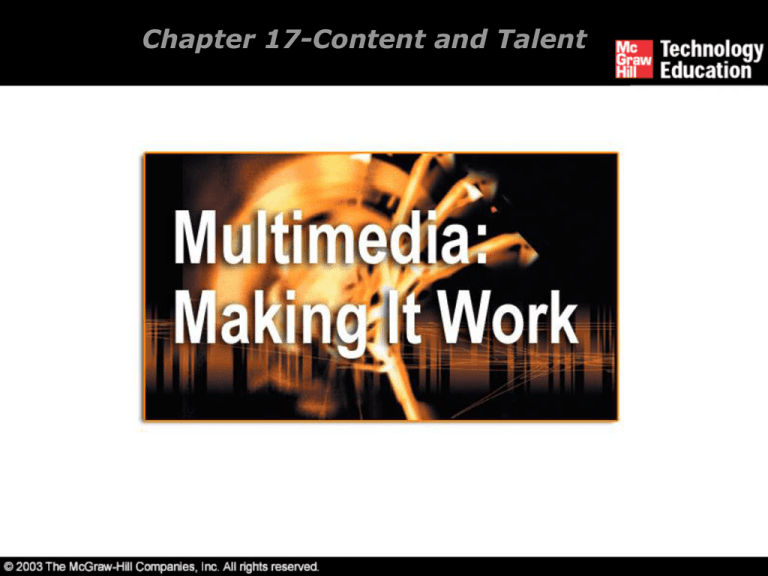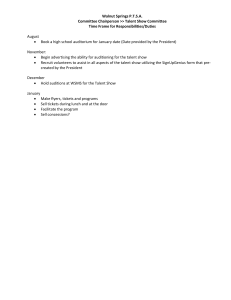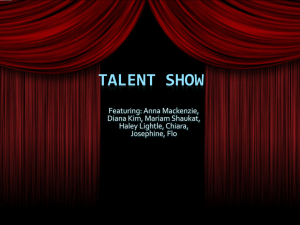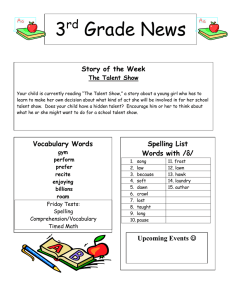Chapter 17-Content and Talent
advertisement

Chapter 17-Content and Talent Overview Introduction to content. Rights required for using content. Using content. Using talent. Introduction to Content Content defines the project information and material. Content can have low and high production value. The basic building blocks of content are films, videos, photographic collections, and textual information bases. Content can be either created or acquired. Introduction to Content Acquiring content can be very expensive and timeconsuming. Financial planning and allocation of sufficient time are important aspects of content acquisition. Pre-existing content can be obtained from a variety of sources. Introduction to Content The sources from where pre-existing contents can be acquired are: Clip art collections - for simple and flexible content. Commercial stock houses - to ensure licensed work devoid of copyright infringements. Introduction to Content The sources from where pre-existing contents can be acquired are (continued): Photo, sound library, and stock footage house - for specific or complex content. The National Archives in Washington - for a rich source of content, both copyrighted as well as in the public domain. Rights Required for Using Content The rights should be licensed to use copyrighted material before a project is developed. Rights for unlimited use should be sought, as the content can be altered any time. Rights Required for Using Content A few issues to be considered when negotiating for rights include: The manner in which the content is delivered. The period for the license. Exclusive or nonexclusive license. Location of product distribution. The quantity of material to be employed. The type of rights. Rights Required for Using Content A few issues to be considered when negotiating for rights include (continued): The credit line or end-credits for display. Whether the content owner has the authority to assign rights. Whether additional rights are required to use the content. The remuneration for the copyright owner. The format for receiving the content. Using Content When a work is created, certain rights are granted to its creator. An electronic right enables creators to publish work in a computer-based storage and delivery medium or on the Web. Using Content Public domain means either the work was never copyrighted or the expired copyright protection has not been renewed. Public domain material can be used freely without a license. Using Content Copyright protection applies to original works of authorship fixed in any tangible medium of expression. The owner's permission must be obtained before a work is used. Using Content Various rights management technologies are emerging and competing to become an industry standard. Any text or image that is copied or incorporated requires the permission of the owner. Such incorporated work is referred to as derivative work. Using Content It is important to obtain a written agreement from every individual contributing to the work. Developing projects includes designing interfaces, writing text, programming codes, and producing musical scores, sound effects, and video. Using Content Several factors must be weighed to determine whether the individual is legally an employee or an independent contractor. These factors include the place of work, the relationship between the parties, and the provision of tools and equipment. Using Talent The required professionals can be located by: Calling a talent agency and explaining the requirements. Reviewing sample tapes and arranging auditions. Advertising for casting calls for screen or audio auditions. Organizing non-union auditions. Using Talent American Federation of Television and Radio Artists (AFTRA) and Screen Actors Guild (SAG) are two union contracts. AFTRA and SAG have similar contracts and terms for minimum pay and benefits. Their contracts are lengthy and detailed, sharing the same language and job descriptions. Using Talent A release form grants certain permissions. It specifies the terms under which the material made during a recording session can be used. Make sure that all talent, even family and co-workers, sign a release form for appearances on tape. Summary Content is the foundation of any multimedia project. Content must be created or acquired. Copyright laws protect the legal rights of the creator of an original work.






